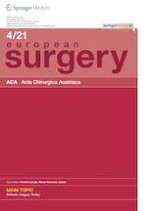Introduction
Methods
Results
Author | Period | Cases (n) | Operation |
|---|---|---|---|
Melvin et al. [9] | 2002 | 1 | Hybrid robotic Ivor Lewis esophagectomy |
Giulianotti et al. [28] | 2000–2002 | 5 | Hybrid robotic McKeown esophagectomy |
Horgan et al. [29] | NP | 1 | Robotic transhiatal esophagectomy |
Kernstine et al. [10] | 2002–2003 | 1 | Robotic Mckeown |
Bodner et al. [30] | 2002–2004 | 5 | Hybrid robotic Ivor Lewis esophagectomy |
Ruurda et al. [31] | 2000–2004 | 22 | Hybrid robotic Ivor Lewis esophagectomy |
Dapri et al. [32] | 2002 | 2 | Hybrid robotic McKeown esophagectomy |
Espat et al. [33] | NP | 15 | Robotic transhiatal esophagectomy |
Van Hillegersberg et al. [34] | 2003–2005 | 21 | Hybrid robotic Ivor Lewis esophagectomy |
Anderson et al. [35] | 2004–2007 | 25 | Hybrid robotic Ivor Lewis esophagectomy |
Kernstine et al. [36] | 2004 | 14 | Robotic Mckeown |
Braumann et al. [37] | 2002–2006 | 4 | Hybrid |
Galvani et al. [38] | 2001–2004 | 18 | Robotic transhiatal esophagectomy |
Boone et al. [39] | 2003–2007 | 47 | Hybrid robotic Ivor Lewis esophagectomy |
Kim et al. [40] | 2006–2008 | 21 | Hybrid robotic McKeown esophagectomy |
Puntambekar et al. [41] | NP | 32 | Hybrid robotic Ivor Lewis esophagectomy |
Dunn et al. [42] | 2007–2010 | 40 | Robotic transhiatal esophagectomy |
Suda et al. [43] | 2009–2011 | 16 | Hybrid robotic McKeown esophagectomy |
Cerfolio et al. [44] | 2012 | 22 | Hybrid robotic Ivor Lewis esophagectomy |
De la Fuente et al. [45] | 2010–2011 | 50 | Hybrid robotic Ivor Lewis esophagectomy |
Diez Del Val et al. [46] | 2009–2012 | 16 | All |
Hernandez et al. [47] | 2010–2011 | 52 | Robotic Ivor Lewis esophagectomy |
Ishikawa et al. [48] | 2010–2011 | 4 | Hybrid robotic McKeown esophagectomy |
Mori et al. [49] | NP | 1 | Robotic transhiatal esophagectomy |
Weksler et al. [50] | 2008–2009 | 11 | Hybrid robotic McKeown esophagectomy |
Sarkaria et al. [51] | NP | 21 | Robotic Ivor Lewis esophagectomy/robotic Mckeown |
Coker et al. [52] | 2006–2012 | 23 | Robotic transhiatal esophagectomy |
Sarkaria et al. [53] | 2012–2013 | 42 | Robotic Ivor Lewis esophagectomy/robotic Mckeown |
Trugeda et al. [54] | 2008–2013 | 18 | Hybrid robotic Ivor Lewis esophagectomy |
Puntambekar et al. [55] | 2009–2012 | 83 | Hybrid robotic McKeown esophagectomy |
Egberts et al. [22] | 2013–2017 | 75 | Robotic Ivor Lewis esophagectomy |
Different RAMIE techniques
Oncological and operative outcomes
Study | Design | Period | Technique | Numbers | EBL | Duration of surgery | Conversion | R0 | Number of yielded LNs | Anastomotic leakage | Morbidity | Reoperation rate | Mortality | OAS/DFS |
|---|---|---|---|---|---|---|---|---|---|---|---|---|---|---|
Meredith et al. [56] | PD | NP | TL vs. TH vs. RAMIE | 95 vs. 643 vs. 144 | RAMIE + TL < TH | RAMIE > TL + TH | RAMIE < TL + TH | RAMIE < TL + TH | RAMIE > Tl + TH | = | RAMIE < TH + TL | NP | = | NP |
Harbison et al. [57] | ND | 2016–2017 | RAMIE vs.TL | 100 vs. 625 | NP | Ramie > TL | = | = | NP | = | = | = | = | NP |
Yang et al. [58] | PD | 2015–2018 | RAMIE vs. TL | 271 vs. 271 | = | RAMIE < TL | RAMIE < TL | NP | = | = | NP | = | RAMIE < TL | = |
Chen et al. [59] | PD | 2016–2018 | RAMIE vs. TL | 54 vs. 54 | = | = | = | = | = | RAMEI < TL | = | NP | NP | NP |
Costs
Standardization of RAMIE
Patient setup for the abdominal phase
Surgical steps of the abdominal phase
Step of operation | Arm 1 | Arm 2 | Arm 3 | Arm 4 |
|---|---|---|---|---|
Lymphadenectomy and gastric and esophageal mobilization | Fenestrated bipolar forceps | 30° camera | Monopolar curved scissors, Harmonic ACE® Curved Shearsa, Vessel Sealer | Tip-up fenestrated grasper |
Gastric tube creation | Fenestrated bipolar forceps | 30° camera | Harmonic ACE® Curved Shearsa | Tip-up fenestrated grasper |
Implantation of feeding probe | Fenestrated bipolar forceps | 30° camera | Large needle driver | Tip-up fenestrated grasper |
Patient setup for the thoracic phase
Step of operation | Arm 1 | Arm 2 | Arm 3 | Arm 4 |
|---|---|---|---|---|
Thoracic esophageal dissection | Tip-up fenestrated grasper | Fenestrated bipolar forceps | 30° camera | Monopolar curved scissors |
Fashioning the anastomosis | Fenestrated bipolar forceps | – | 30° camera | Large needle driver |
